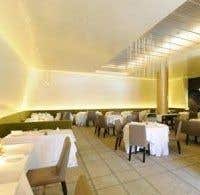This article was also published in the Financial Times.
Corton used to be Montrachet.
Before this statement strikes consternation into lovers of Burgundy, where Corton and Montrachet are two of the most revered vineyards, or those who have invested in any of the expensive bottles that bear either of these names, let me explain that this transformation refers to a restaurant in Tribeca, New York. After 23 years as Montrachet, a complete and extremely elegant redesign at a cost of over US$2 million has yielded Corton, which opened for business on 1 Oct 2008.
The only obvious reminder of the restaurant’s former incarnation is the bar immediately to the right of the front door. Other than that, the makeover is total. The private room has been removed to make way for a state of the art kitchen that can be seen through a broad rectangular window to reveal a large kitchen brigade hard at work. The overall effect is a far more open, modern and luxurious dining room.
The cool, white decor is enlivened by three large and stylish floral displays. The walls are covered in a bas relief of trees and birds; the lighting is discreet; the acoustics are good – particularly by New York standards – and there is a definite sense of comfort. Drew Nieporent, Corton’s owner, is only too aware that in today’s market the timing of his investment could have been better but he has, at least, the consolation of a distinctive setting.
And while Nieporent has always offered a particularly exciting wine list, equal prominence has now been given to the food under British chef Paul Liebrandt, whose menu offers a seven-course tasting menu at US$110 (which, on the night we ate there, included Scottish red-legged partridge with quince) and a three-course menu at US$76 per person with half a dozen options at each course.
The latter yielded not only some exciting dishes but also some original presentation. The slice of foie gras stood vertically on the plate wrapped in a beetroot gelée; a mound of white Peekytoe crab was served in a bowl, its inherent sweetness accentuated by pickled chanterelles and Meyer lemon; while crisp cubes of veal sweetbreads, an increasingly common ingredient on the city’s menus, were cleverly paired with carrots and a poached egg under slices of crisp potato.
These high standards extended into the main courses, particularly a boned squab pigeon with a chestnut cream and striped bass with a razor clam chowder. A lively dessert of quince sorbet with apple, shiso leaf and lime soup nicely whetted the palate for a range of chocolates offered in clear Perspex boxes.
And the wine list seems even more enticing perhaps because of Corton’s knowledgeable sommelier Elizabeth Harcourt, whose youthful features probably lead to her being asked for her ID before being served in any other restaurant. We drank a 2004 Alsace Riesling from Binner (US$45) and, on her recommendation, a 2004 Gevrey-Chambertin from Harmand-Geoffroy (US$95), both of which were excellent examples of their grape and region.
The rest of the staff are equally enthusiastic – in fact my only criticism of the service was that our first course was cleared away before one of our table had quite finished. Nieporent himself hovered, dashing from table to table and then into the kitchen until there was a lull when he would retreat into a corner to talk quietly on his mobile phone.
Corton the restaurant has been built to last – just like the wines that bear this particularly distinctive appellation.
Corton, 239 West Broadway, New York 10013. Tel 212-219-2777, www.cortonnyc.com

